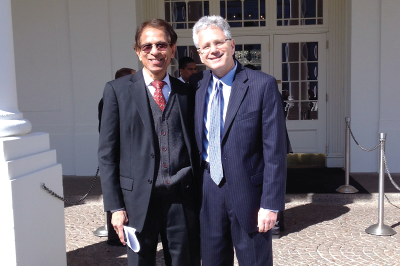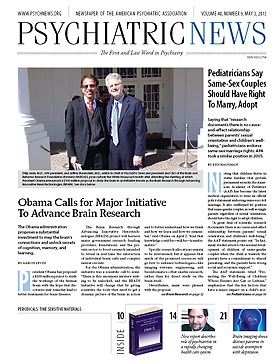President Obama has proposed a $100 million project to study the workings of the human brain with the hope that discoveries may someday lead to better treatments for brain diseases.
The Brain Research through Advancing Innovative Neurotechnologies (BRAIN) project will harness major government research funding providers, foundations, and the private sector to boost research intended to reveal in real time the interaction of individual brain cells and complex neural circuits.
For the Obama administration, the initiative was a scientific call to arms. “There is this enormous mystery waiting to be unlocked, and the BRAIN Initiative will change that by giving scientists the tools they need to get a dynamic picture of the brain in action and to better understand how we think and how we learn and how we remember,” said Obama on April 2. “And that knowledge could be—will be—transformative.”
Specific research allocations remain to be determined, but it appears that much of the promised resources will go first to enhance technologies—like imaging systems, engineering, and bioinformatics—that enable research, rather than for direct study on the brain itself.
Nevertheless, many were pleased with the proposal. “This is a once-in-a-lifetime opportunity for neuroscience to advance,” said APA President Dilip Jeste, M.D., who attended the White House meeting with other scientists and researchers. “The more we know about the brain, the more we will know about brain diseases, including serious mental illnesses, and the more we can benefit patients with psychiatric disorders.”
Historically, researchers have looked more for the places in the brain where activity occurs, but now there is an increasing emphasis on brain networks, observed Sheldon Benjamin, M.D., a professor of psychiatry and neurology and vice chair for education at the University of Massachusetts Medical School.
To expand knowledge of those networks, the BRAIN Initiative will link research supported by the Defense Advanced Research Projects Agency (DARPA), the National Science Foundation (NSF), and the National Institutes of Health (NIH), which will coordinate the effort.
NIH Director Francis Collins, Ph.D, appointed Cornelia Bargmann, Ph.D., a professor at Rockefeller University, and William Newsome, Ph.D., a professor of neurobiology at Stanford University School of Medicine, to co-chair an advisory committee that will develop the initiative’s scientific goals. They will deliver a preliminary report by next fall.
The NSF said it will support development of “molecular-scale probes that can sense and record the activity of neural networks.”
“DARPA will use existing funds to advance fundamental understanding of the brain’s dynamics to drive applications, manufacture sensing systems for neuroscience applications, and analyze large data sets,” said Geoffrey Ling, Ph.D., deputy director, of DARPA’s Defense Sciences Office, in an interview with Psychiatric News.
The agency will develop technologies to repair or restore memory loss and will investigate how to improve diagnosis and treatment of troops who experience posttraumatic stress disorder or traumatic brain injury.
“However, these insights into restoration mechanisms may also prove valuable in the effort to treat other illnesses and aging-related memory loss in the broader population,” said Ling.
In addition, the Howard Hughes Medical Institute will contribute $30 million to the initiative and the Salk Institute for Biological Studies another $28 million. The Kavli Foundation will add $4 million annually for 10 years. The Allen Brain Institute for Brain Science plans to allocate $60 million annually to continue research begun in 2012 on how brain activity relates to perception, decision making, and action.
The proposed initial federal allocation is $40 million in Fiscal 2014, according to an NIH statement.
“It’s not entirely clear how the funding will work,” said Benjamin. “We don’t want to draw funds away from other important psychiatric research. We must keep advocating, but it’s hard not to be enthusiastic.”
“We want to be clear, this won’t happen overnight,” said Collins, at a follow-up question-and-answer session. “But we will use these new technologies to learn the language of the brain and utilize that to build new insights into Alzheimer’s disease, epilepsy, schizophrenia, Parkinson’s disease, autism, traumatic brain injury, and posttraumatic stress disorder.”
Most of the BRAIN Initiative’s research over the next decade likely will concentrate on animals, work that will serve as a foundation for human studies, suggested Benjamin, who is also president of the American Neuropsychiatric Association.
“Mapping the whole brain in 10 years is quite unlikely,” he said. “We’ll need to prove concepts in simple creatures like C. elegans, with known, limited nervous systems, then move up from there. However, some technologies—like imaging application—may be adapted more quickly for use with humans.”
Benjamin is also the training director at UMass and sees implications for current and future psychiatry residents.
“Psychiatric educators must think about how to provide basic training in this aspect of neuroscience so that psychiatrists won’t be left behind,” he said. “We want them to be at the table to benefit from these developments when they are available in the clinic.”
“It will take a lot of effort to achieve all this,” said Jeste. “It is more complicated than the human genome project, because that had a specific outcome in mind. That makes this much more challenging and, at the same time, much more exciting.” ■

